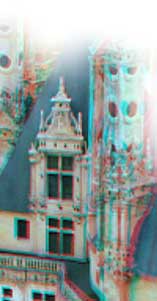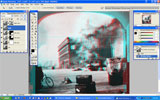 |
||
 |
Presentation of the Project
|
|
 |
|
A 3D movie for the 1906 Centennial. |
|
When planning the 1906 SF earthquake centiennal exibition, the State Capitol Musem, Sacramento, wanted to ofer its audience an amazing cinematographic experience. They choosed Fakespace to retrofit the existing theater with a digital 3D system. They hired DesignMedia to produce the Stereoscopic / 3D movie. I was in charge of the 3DTV direction and 3D equipment oversight. By the end of the project, I had redesigned the digital cinema system and assumed the whole VFX supervision. |
|
Selecting assets for optimal 3D effect. |
|
 |
The 1906 earthquake was a media event by itself. Even if South California was not yet the center of the world entertainement, even if the silicon valley was not pourring supercomputers and internet services all around the world, San Francisco was already a rich city flooded with tech-savys early-last-century geeks. As a result, we've got movies, tons of pictures and a impressive amount of stereograms, i.e. 3D pictures of the disaster. For the 1906's Stereoscopic Camera had an fixed inter-occular distance, and were aimed at "stereoscopes" viewing systems, we could not take for granted they would be ecploitable assets. We selected them on many criteria, including monoscopic quality, stereoscopic quality, stereoscopic base, and restaurability. |
Digitial restauration of historical stereograms. |
|
 |
1906's Stereograms used to be printed on 2"x2". We were planning to digitaly project them on a 12' wide screen. A single nail scratch would have been a finger wide black strip on the screen, destroying the stereoscopic effect and breaking the magic of the storytelling. The process included :
On some picture we had to rebuild the whole scene geometry by squewing points of view. The hardest job was done on the panoramics views, for most of them are not actual stereo pictures, but more likely, dark-room generated stereoviews, based on hand-made cut-and-paste. |
Let the audience feel the quake : CG and VFX on purpose |
|
 |
More that telling a story, we wanted the audience to exprience what being catch in an earthquake was all about. Based on first-hand witnessing, we selected four experiences to be re-enacted on screen.
We selected landmark views of quake-affected San Francisco to represent them. Using Geometry Reconstruction, Projection Mapping and Texture Animation, we generate the "quake revival" sequence. |
Listen to dancing rocks : The sound of the quake. |
|
 |
A 3D movie deserve a 3D sound. James LeBrecht, from berkley sound artists make a Sourround Sound mix that match and enhance the immersive exprience provided by the 3D movie. |
Edit the movie in 3D-HDTV. |
|
 |
The movie is digitally projected with HDTV wide screen projectors. It would have been a shame not to produce the content at that state-of-the-art quality level. All the assets were restored to HDTV+ resolution. All the CG content were produced at HDTV+ resolution. The final edit and conformation is done in 3D-HDTV, allowing later airing on HDTV program or release on HD-DVD. To that purpose, specific Stereoscopic Compositing tools were developed |
Delivering the experience : 3D-HDTV Projection. |
|
 |
The State Capitol digital 3D theater uses passive linear polarized
stereoscopy. |
|
Bernard Mendiburu 6, rue Civiale, 75010 Paris, France |
